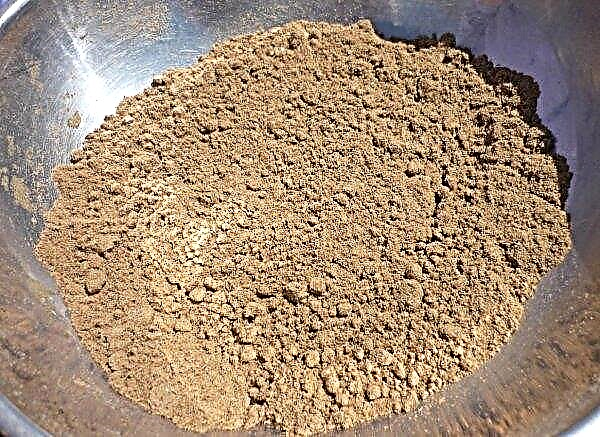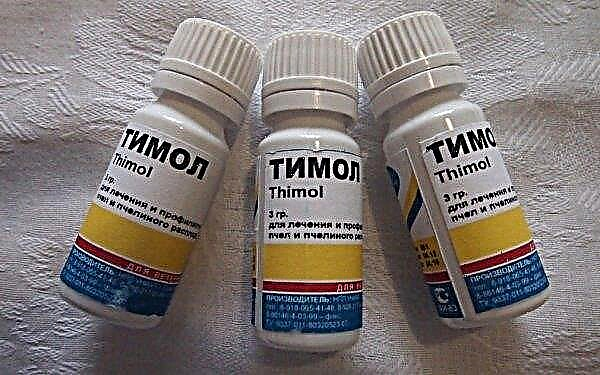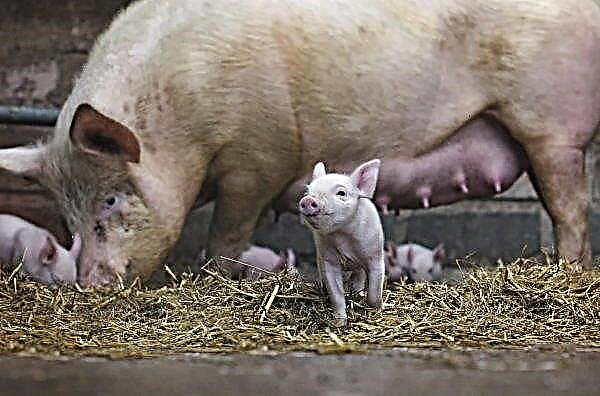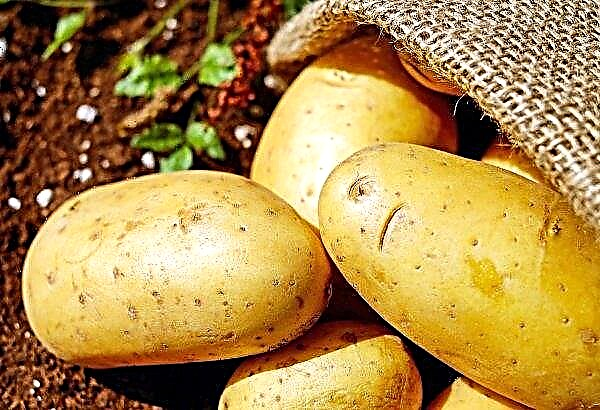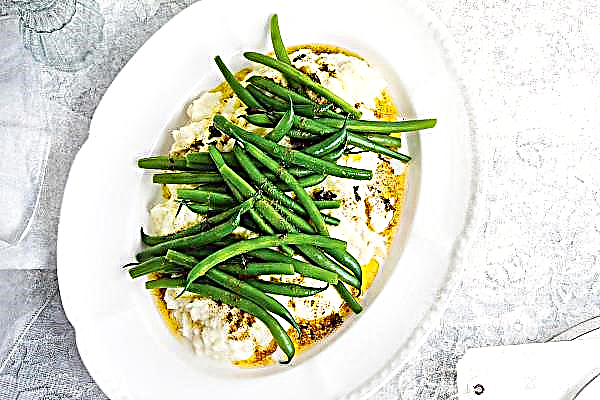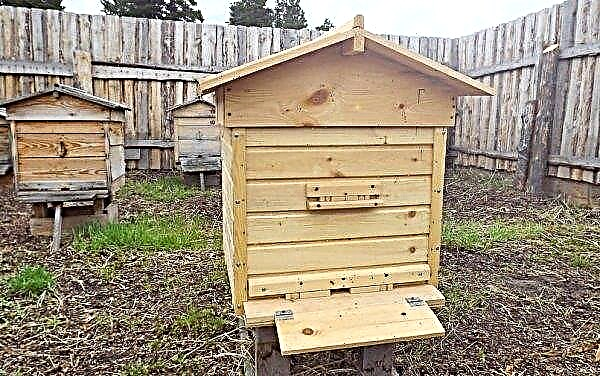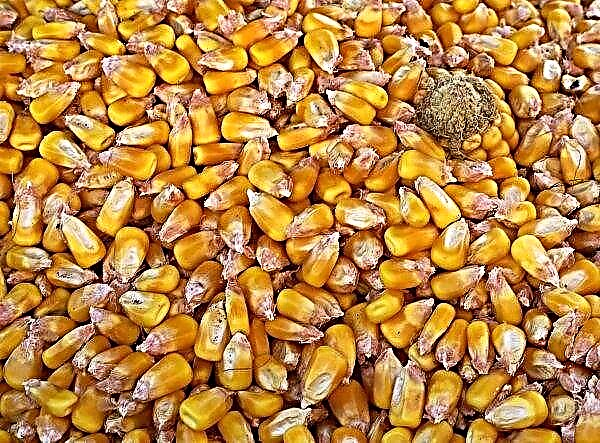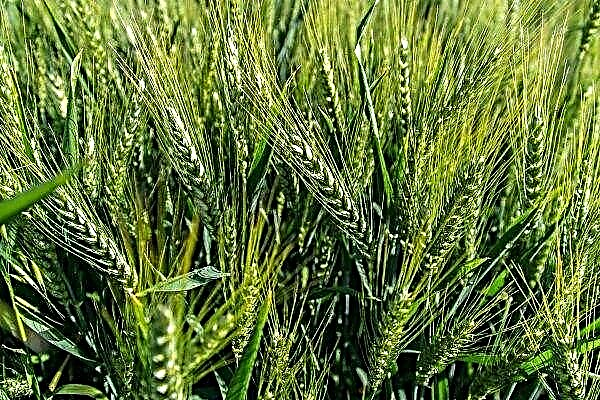Polycarbonate, as a coating material, is most often used in organizing home greenhouses. It has excellent technical and operational properties, easy to install and is able to last for many years. About how to properly cut a polycarbonate sheet on the ends of the greenhouse, and how to correctly calculate the required number of sheets - later in the article.
The main mistakes when cutting polycarbonate for a greenhouse
Polycarbonate is a transparent plastic of moderately hard structure, polymer type. The main advantages of the material are its high light transmission, low weight, ductility, ability to recover, durability and ease of use. As a rule, sheets of cellular polycarbonate, which is characterized by a cellular structure, that is, by the presence of voids and cells with partitions inside, are used to cover home greenhouses.
Did you know? Monolithic polycarbonate sheets appeared in 1955. The main scope of their application was the space and defense industries, where the material was used to make parts for military equipment, aircraft, spacecraft.
For the manufacture of frameworks of structures, steel profile pipes are used. In most cases, such greenhouses are installed directly on the ground, without building a foundation. However, in order for the device to last for many years, while performing all its functions, it is necessary to properly prepare the coating material.
In the process of cutting sheets, many masters make a number of typical mistakes:
- the sheet is fixed “through and through”. With this fixation, over time leaks will form at the fixation points;
- incorrect positioning of panels in the plane, especially when covering broken or spherical roofs. Correct is the orientation of the sheets in the direction of the slope or bend;
- too thick polycarbonate. Thick material is more difficult to cut, while it costs much more. When choosing sheets should take into account the recommendations of specialists;
- non-compliance with the tolerances required for thermal expansion. One of the qualities of polycarbonate is its "breathable" ability, which is especially noticeable at temperature extremes, so it is very important to observe the tolerances;
- cutting not along, but across voids. Cross section increases the risk of breaking panels;
- non-compliance with the rules for fixing the edges panels.
Tools
In the process of constructing a greenhouse device, summer residents are faced with the need for cutting and cutting polycarbonate material. Such events are recommended to be carried out with great care and accuracy, because the quality and ease of installation of the material will depend on how well the cutting will be done. That is why, beginning masters should carry out cutting according to a previously prepared scheme, as well as after consulting with a specialist.
Important! So that in the process of cutting as little as possible waste materials, all work should be performed according to drawings made according to one of the selected, most budgetary schemes.
For working with polycarbonate, you will need ordinary, traditional tools:
- wood or plastic hacksaw;
- circular or manual saw;
- sharp clerical knife.
When cutting, you should adhere to several important rules:
- the protective film is not removed from the sheets until the end of the cutting work;
- after each cut, the resulting sawdust is removed from the recesses. To do this, use the method of blowing garbage using compressed air;
- when cutting waste materials there should be a minimum quantity;
- cut not one sheet of material, but immediately a stack, which avoids cracks;
- with polycarbonate, ideally, they work together: one person cuts the panels, the other holds them.

Features of polycarbonate cutting for ends
The ends of the greenhouse are considered to be the most difficult during the cutting process, since there are many different elements in them, and each incorrectly made cut can spoil all the work. Events are recommended to be carried out sequentially, carefully following the basic rules.
Sequence
Strict adherence to the sheet cutting algorithm guarantees the efficiency, ease and quality of work.
Site preparation. Before proceeding with the cutting, thoroughly clean the place from extraneous, excess objects. Dry branches, small pebbles or boards can damage the integrity of polycarbonate sheets and lead to the formation of chips, cracks, dents, which are almost impossible to get rid of. For the convenience of work, the surface is covered with a sheet of plywood or wood board.
Blueprints. Before cutting plastic, preliminary make drawings of cutting.
The diagram may look like this: 
Polycarbonate is installed on the work surface, while the protective film is not removed until the end of the work. By means of a marker pen and a ruler, paper markings are transferred to plastic panels. On both sides of the layout, there are supporting boards under the sheets, 4 cm high and 10 cm wide. Moreover, the length of the supports should be slightly longer than the polycarbonate sheet itself.
Section of the panels. To make accurate cuts along the planned drawing lines, use: for a flat line - a grinding grinder, for circles - a jigsaw. All small inaccuracies, uneven edges that arose during the cutting process, are adjusted with the help of a clerical knife.
Important! When working with a jigsaw or grinder, personal protective equipment, in particular, special glasses, must be used.
After cutting the sheets from their surface, you need to remove all debris and sawdust, and treat the ends with a sealing punched tape, which prevents the accumulation of dirt, dust or moisture inside empty cells.
Polycarbonate web direction
As noted above, cutting canvases at the ends is carried out in two directions:
- from top to bottom on a slope;
- on the bend of the frame.
In order not to make a mistake with the direction, you need to pay attention to the protective film glued on the inside, which has the corresponding marking. On the outside of the canvas there is a special coating against ultraviolet flux. Sheets are cut quite easily, along a honeycomb tube, which acts as an excellent limiter for the blade. Crosswise and diagonally, the canvas is not cut, since there is a high probability of cracking, and besides, quite a lot of effort will be required to cut it. Across the plastic cut in two stages: first cut the top layer, and then finally divide the sheet into two parts.
Crosswise and diagonally, the canvas is not cut, since there is a high probability of cracking, and besides, quite a lot of effort will be required to cut it. Across the plastic cut in two stages: first cut the top layer, and then finally divide the sheet into two parts.
Material calculation
The calculation of the amount of materials is an important step in carrying out coating work. When installing canvases, it is advisable that all joints fall on the bearing components of the greenhouse, and this rule should be observed for both gable structures and for arched ones. Also, experts advise to pay attention to the interval between the ribs. The length of the finished polycarbonate sheets can fluctuate, depending on the manufacturer.
Did you know? Due to its high light transmittance, polycarbonate is widely used in optics. It is used to produce lenses for different types of glasses. Moreover, polycarbonate lenses are 200 times stronger than glass ones.
The best option for arched devices is considered to be 10-12 m. For pitched structures, according to the "house" type, it is better to choose medium-length canvases so that it is more convenient to work with them when cutting. The amount of material needed will depend on the size of the entire greenhouse. There are special online calculators on the Internet with which you can quickly calculate the amount of materials required to assemble various types of structures: rectangular, semicircular, arched, etc. Cutting out polycarbonate sheets for covering a greenhouse requires some effort, knowledge and accuracy from the master. To do all the work efficiently, you need to choose the right canvas that meets certain characteristics, prepare the drawing and the necessary tools, carefully study the cutting algorithm and use the services of an assistant.
Cutting out polycarbonate sheets for covering a greenhouse requires some effort, knowledge and accuracy from the master. To do all the work efficiently, you need to choose the right canvas that meets certain characteristics, prepare the drawing and the necessary tools, carefully study the cutting algorithm and use the services of an assistant.

